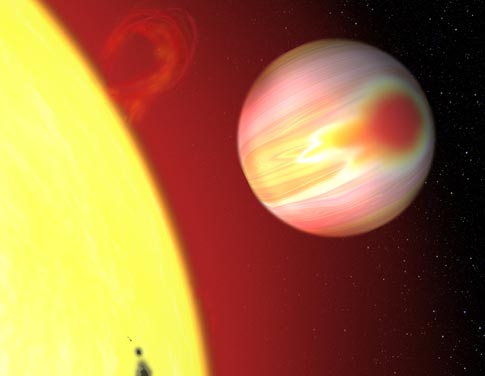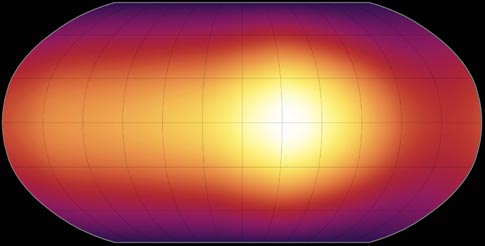For the first time, astronomers have created a rough map of a planet orbiting a distant sun-like star, employing a technique that may one day enable mapping of Earth-like worlds. Since the planet just charted is a gas giant and lacks a solid surface, the map shows cloud-top features. Using the Spitzer infrared space telescope, astronomers detected a bright hot spot that is offset from “high noon,” where heating is greatest.
“We are getting our first good look at a completely alien world,” said
Heather Knutson, a graduate student at Harvard University and lead author of a paper about the research appearing in the May 10 issue of the journal
Nature.
“We felt a little like Galileo must have felt when he first glimpsed Jupiter through the eyepiece of his telescope,” Knutson continued.
Spitzer is only capable of mapping large, hot worlds — planets too hot for
liquid water or life. However, the upcoming James Webb Space Telescope
(scheduled for launch in 2013) may be able to map Earth-like worlds using
the technique Knutson and her colleagues pioneered.
Over the course of 33 hours, the team collected more than a quarter million data points. Although Spitzer could not resolve the planet into a disk, by measuring changes as the planet rotated, the team created a simple longitudinal map. That is, they measured the planet’s brightness in a series of pole-to-pole strips across the planet’s visible cloud-tops, then assembled those strips into an overall picture.
“We can see the changes in brightness as features in the planet’s atmosphere rotate into and out of view,” Knutson explained.
The map revealed a single “hot spot” that is about twice as big as the Great Red Spot on Jupiter and much hotter. The Great Red Spot is only about 30 degrees Fahrenheit warmer than its surroundings, with a temperature of -200 degrees F. In comparison, the hot spot on HD 189733b is a scorching 1700 degrees F.
Interestingly, researchers found that the hottest point on the planet is not the substellar point (“high noon” on the planet), but rather is offset by about 30 degrees longitudinally. They speculate that the shift is due to winds redistributing heat across the face of the planet.
“This planet has powerful jet streams. While Earth’s jet stream blows at
around 200 miles per hour, the jet stream on HD 189733b may blow as fast as
6,000 miles per hour, according to computer models,” said co-author David
Charbonneau (Harvard-Smithsonian Center for Astrophysics).
The distant planet’s strong, hot winds may also help to keep the planet’s
night side warm. Without winds, the side facing the star would broil while
the opposite side would freeze. However, the astronomers measured a maximum temperature difference of about 500 degrees F. The coldest regions on the night side remain a balmy 1200 degrees F.
“Every night is hot on this world,” stated Knutson.
HD 189733b orbits a star slightly cooler and less massive than the Sun
located about 60 light-years from Earth in the direction of the
constellation Vulpecula. It is the closest known “transiting” planet to
Earth.
HD 189733b orbits its star at a distance of only three million miles,
completing one revolution every 2.2 days. Its mass and physical size are
both slightly larger than Jupiter.











